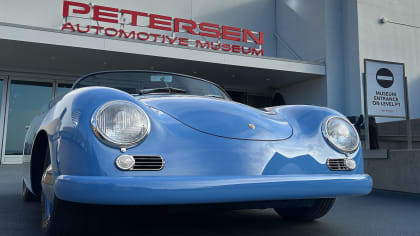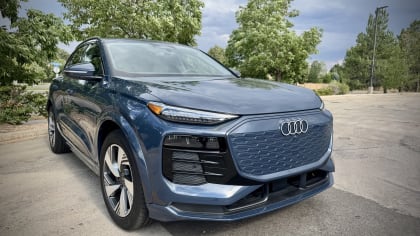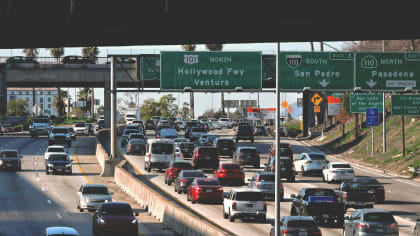NASCAR QUALIFYING
The calm before the storm
This article is from our archives and has not been updated and integrated with our "new" site yet... Even so, it's still awesome - so keep reading!
Published on Sat, Mar 23, 2013
By: The LACar Editorial Staff

Story and pictures by Brian Kennedy
If you got out to Auto Club Speedway in Fontana Friday to see NASCAR practice and qualifying, you might have had one impression: everything about the experience is enormous.
There’s a homespun quality to the series that goes back to its roots and which is prized as a way for fans to connect. “Good old boys just racin’ what they brung” is the ethos they’re going for. There might be a bit of that, especially in NASCAR’s heritage and that fact that, wandering around the garage, you do hear Southern accents. But in fact, nothing about the sport is simple.
The track, itself, for one thing. Huge grandstands tower to your right as you drive in off Cherry Avenue. They seem to go for a mile. In fact, that’s pretty close to how long they are.
When you get inside and see them from the infield, they’re immense. Friday for qualifying, while there were a lot of people around, including a huge tent city (really, super-chic motorhome city) in the infield, not too many were sitting in the stands. Those who were there were dwarfed by the immensity of what surrounded them.
Then there’s the track surface. On TV, it looks easily one-third its real width. The length, too, is cheated by the TV camera. At two miles, a lap takes about 38 seconds. Thinking about it, that doesn’t seem all that long. But consider that your favorite car goes by you, and by the time it’s gone halfway around the track, it’s so far away that even from a raised position in the stands, it looks like a tiny toy model.
There’s something amazing about that. Being there, you kind of get the feeling that you’re a part of something way bigger than you are. Forget the myth of the aw-shucks Southern racer. This is almost magic.

And that brings us to the cars. Sure, they look like street cars, more so than in the recent past, as I’ve detailed earlier in the week. But look inside, and the myriad of hoses, wires, safety tubing and seating will astound you. Look under the hood and you’ll find the 358CID engines that are the series’ standard, but atop them, beautifully crafted mechanical marvels of fuel injection.
There’s also a funny sensation that happens when you see a Sprint Cup car up close. It looks both bigger than you thought it would, in that the sides are bulky and tall, and smaller. Maybe it’s because of the ride height. Look at the driver’s position, though, and it’s obvious that these guys don’t have a lot of space to work in. It’s practically claustrophobic, and the impression is that it takes a brave person to do what these drivers do.
Look at the car sitting still on the tarmac, as I did while they sat in the tech line, you’ll notice that the driver’s side front wheel is so much cambered out that its top sticks out way past the fender lip. On the other side, the front wheel doesn’t touch the ground on the bottom side for a few inches, until halfway along the tread width. Why? Going left, it seems, is easier that way.
Then there’s tech itself. No longer a process where officials take tools to measure ride height, weight distribution, etc., tech is now a process where each car is driven up onto a ramp, wheels hooked up to a series of devices which measure weights and dimensions, and three or four minutes later, after officials have scrutinized the graphic readouts on a computer monitor off to the side of the garage, the car rolls off and the next one takes its place.
After the race, according to a crew member I spoke with, no engine teardowns are done at the track any more. If there were a question that the series needed satisfaction on, they would do their scrutineering work in Charlotte.

The bodies, too, must be checked to see that the fit into the dimensions required. If you’re imagining that this happens with a bunch of rulers and triangles, think again. Remember the “cone of silence” in Get Smart? It was a dome that came down from the ceiling to keep conversations private. Well, the body template machine kind of reminds me of that. There’s a metal superstructure holding up a kind of jig that looks like the inner structure of an airplane to my eye. It is lowered onto the car so that gaps can be measured.
Then there’s the equipment it takes to run a team. Tires are taken from place to place on purpose-built handcarts. The toolboxes in the garages seem specially designed to be slim-fitting but hold the maximum gear. When a team goes to the pits to run practice laps, a tiny, custom-made tool kit goes with. The gas cans, themselves high-tech, aircraft-grade stuff, are held, three up, in a custom carrier.
I can’t imagine paying the bills just to get a team ready to go to the track, let alone building a car and getting it past inspection to run a lap. Talking to a crew member from the Caterpillar Chevrolet team of Jeff Burton, I learned that the tire pressure monitor they use is aircraft-grade, and it’s worth $375. So when you hear the commentators say, “They took half a pound out of the right rear,” and you think about your gauge at home, which was ten bucks at Target, think again. The ones these guys use are accurate to 1/10th of a pound.
If you’re a car person, you probably have a floor jack in your garage. You’ve seen the NASCAR ones, too, and probably know they’re aluminum. Well, each one of those is $1500.
The other thing that strikes me walking around and standing in a group talking to drivers Kasey Kahne and Jeff Gordon outside their haulers is that, while the driver is the face of racing, and the wins and losses become his, or hers, that person is really just a tiny tip of a huge spear.
He (or she) has a job to do. It’s the ultimate job, the one that ends up on TV and that can be measured in time, speed, laps lead, and so on. But that job is so dependent upon so many people that what this really is, despite all the friendly rhetoric and the admiration of fans that is absorbed by drivers, is an enormous, expensive, complicated business. A business in the sense that there’s pressure. That there are winners and losers. That it’s so big and so complex that if a driver ever stopped for a second and thought about his place in it and the fragility of that, or, to say it the opposite way, the enormity of his (or her) talent and the depth of belief that ownership has to have in that tiny, fragile person (almost, I mean that, literally, in Kahne and Gordon’s cases. They’re very small compared to today’s average American), then the pressure would have to overwhelm them.
The fact that they can do what they do tells you why they make the money they make. It’s why so many people at small tracks all over the country every weekend of racing season are trying to get there themselves, and why, despite their desire, only a tiny fraction of them make it.
This is NASCAR. As a feature of American popular culture, it’s huge, like everything else here. But that is not a criticism. It’s a call for you to appreciate what’s done weekend by weekend, and this weekend, in your own backyard. Sure, it’s built on corporate money. Sure, the drivers live in a very odd and tiny bubble. They have to, or they couldn’t get a moment’s peace to concentrate on their skills. But like they always say, when they do finally get in the cars, it’s their office, and they can do their work. Sunday, you get the chance to see them do that.

Qualifying day brought a couple of interesting tidbits from stars Kahne and Gordon.
LA, because two miles, there’s times here where you’ll bump and push a little bit, but not near as much as other places. I think you’ll see it [Sunday]. Our bumpers aren’t far enough off that I don’t think it should be too much of a deal at this place.” The double negative, cancelled out, seems to say that the bumpers are close enough that they could do some bumping. Look for that in the race.
He further said that getting a win early and getting it out of the way is a good thing. “I don’t know if that’s the soonest I’ve got one [race 4, in Bristol last weekend], but it seems like it.”
Talking about this year’s car, he said, “as a driver,” the new car “gives you more overall grip. You can push harder, on entry, pick the throttle up, be underneath another car and not be afraid of losing it. It gives you a little bit more security with what you’re doing.”
He said about his practice run and the setup for race day that happens Saturday, “Hopefully we’ll put in something that will make us a little bit better tomorrow. It’s still a learning curve everywhere we go right now.”
He also talked about a tattoo that he recently got. “I haven’t had too many people get mad about it or anything yet. I think that it’s fine; if it’s meaningful and something you want to do, then go for it.”

Jeff Gordon was asked about the car and its lightness compared to last year. The cars are now 150 pounds lighter than they were. He said that this hasn’t made that much difference in the drive. “The weight is not significant. If they started pulling five and six hundred pounds out of these cars, then I’ll make a comment on weight,” he said. Getting onto technical issues, Gordon said, “We’re always pushing the limits. Always have done. Pushing the limit, you find the weak link. As you go faster, you start to find where the weak links are.” He was referring to losing a tire bead last weekend due to overheating his tires. He went on to explain how the tire bead is cooled, and the complexity of systems that are in place to make that happen. You get the feeling that the technical points of this kind of racing are incredibly more complicated than can be seen by the casual eye. Gordon further echoed Kahne’s point about the new car, saying that there’s a lot to learn. Weights, the rear sway bar being eliminated, these must be dealt with. “The rear sway bar played a role for us. We had that mapped out very well in how to balance the car out. It’s been a challenge for us to get the car to turn in the center of the corner and have the security of the rear on entry and exit without that rear bar.” Last year, he said, his team ended well. “We hoped that that momentum would carry over so that we could start the season out strong.” That hasn’t happened yet, but “Don’t count us out, that’s for sure.” He added that he thinks the biggest test for him and his team with this new car will come at Texas. That race comes in the middle of April. Next week, by the way, the series is off. Gordon said he and his family will be doing some skiing on the break. Follow me on twitter @growinguphockey Read Brian Kennedy’s “NASCAR at Auto Club Speedway” Read Brian Kennedy’s “NASCAR’s ENTIRE HISTORY in less than 1000 words” Read Brian Kennedy’s “NASCAR WARS – A New Hope” [nggallery id=qualifying]




